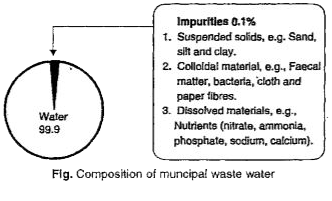What do you mean by water pollution? Explain the sources and ill-effects of water pollution.
It is the degradation of quality of water due to addition of substances inorganic, organic, biological, radiological), factors (e.g., heat) and deprivation that makes it health hazard, unfit for human use and growth of aquatic biota. Water pollutants belong to three categories-biological, chemical and physical, (i) Biological. Various pathogens, e.g., viruses, bacteria, protozoa, helminthes, algae, (ii) Chemical. Organic wastes, organic biocides (e.g., DDT, BHC) and poly-chlorinated biphenyls (PCBs), inorganic chemicals like As, Pb, Cd, Ni, Hg, phosphates, nitrates, fluorides, etc. (iii) Physical. Hot water, oil spills.
Sources of Water Pollution. They are of two types :
(a) Natural Sources of Water Pollution. Clay and silt from soil erosion, teaching of minerals, falling of organic matter from the banks.
(b) Anthropogenic or Man-Made Sources of Water Pollution. Domestic waste, sewage, soaps and detergents, run-off from agricultural fields having fertilizers and pesticides, industrial wastes, heat, waste from animal sheds and slaughter houses, oil pollution, etc.
(i) Municipal Waste Water. It contains sewage, domestic or household wastes, detergents and some animal as well as industrial wastes. Mostly biodegradable, contains phosphate and nitrate, pollute rivers and lakes.
(ii) Industrial Waste Water. Hot water is released by industries using steam as well as those which use water as coolant. Industrial waste waters contain a variety of organic and inorganic residues, All rivers and water bodies are heavily polluted by them. Coastal waters are polluted by prawn culture farms, fish processing and other industries.
(iii) Surface Run Off. Run off from agriculture land is polluted with pesticides and fertilisers. Storm water from urban and industrial sites contain a lot of biodegradable as well as toxic metals, acids and other chemicals.
(iv) Oil Spills. They are accidental discharges of petroleum from oil tankers, offshore oil drilling and oil refineries.
In urban areas 90% of water pollution is due to human wastes and 10% by industrial wastes. In open, 58% of all water pollution is due to agricultural run-off. Here mining industry is the second major pollutant.
Domestic Sewage.
It consists of everything that passes into sewer from residential areas, i.e., human excreta, food residue, detergents, etc. Wastes from animal sheds, slaughter houses and food processing industries also carry similar contents. Only 0.1%, of municipal waste water (Fig.) consists of sewage impurities. The rest 99.9% is water. There are four types of impurities and dissolved solids.
(i) Pathogens (Contaminants). Raw sewage contains a number of pathogens (typhoid, dysentery, diarrhoea, cholera, giardiasis, amoebiasis, helminth eggs), coliforms and enterococci. Number of intestinal bacteria (e.g., coliforms, entero-cocci) is an indication of pollution caused by raw sewage. Table 16.3. gives the degree of contamination of river Yamuna (=Jamuna) in Delhi, Agra and Mathura.
Impurities 0.1%
1. Suspended solids, e.g., sand, silt and clay.
2. Colloidal material, e.g., Fecal matter, bacteria, cloth and paper fibres.
3. Dissolved materials, e.g., nutrients (nitrate, ammonia, phosphate, sodium, calcium).


(ii) Suspended Impurities. They are suspended solids mostly made of sand, silt and clay. Most of the solids tend to settle if waste water is left undisturbed for sometime.
(iii) Colloidal Particles. They are both inorganic and organic components of sewage. The major inorganic colloid is clay. Organ colloids consist of faecal matter, bacteria and other microorganisms, cloth and paper fibres. Colloid particles form a near permanent colloidal solution. They can be removed only through decomposition of organic matter and addition of chemicals that cause flocculation or clumping of colloidal particles.
(iv) Dissolved solids. Both organic and inorganic compounds form this fraction Amongst inorganic solids are nitrates, phosphates, and toxic metal ions.
Topper's Solved these Questions
- ENVIRONMENTAL ISSUES BOOK - BETTER CHOICE PUBLICATIONCHAPTER - ENVIRONMENTAL ISSUES EXERCISE - SHORT ANSWER
44 Videos
- ECOSYSTEMBOOK - BETTER CHOICE PUBLICATIONCHAPTER - ECOSYSTEMEXERCISE - MOST EXPECTED QUESTIONS
30 Videos
- EVOLUTION BOOK - BETTER CHOICE PUBLICATIONCHAPTER - EVOLUTION EXERCISE - LONG ANSWER TYPE QUESTIONS (5 Marks) (MOST EXPECTED QUESTIONS)
13 Videos
Similar Questions
Knowledge Check
What are the main sources of water pollution?
AMunicipal sewageBIndustrial wasteCRiver waterDBoth (a) and (b)
What are the negative effects of water pollution on human health?
View SolutionWhat are the major causes of water pollution? Explain.
View SolutionWhat are the major causes of water pollution? Explain.
View SolutionRead the paragraph and answer the questions following it.
Water is essential for life. Without water there would be no life. We usually take water as granted for its purity, but we must ensure the quality of water. Pollution of water originates from human activities. Through different paths, pollution reaches to ground water. Easily identified source or place of pollution is called as point source, e.g.– municipal and industrial discharge pipes, where pollutants enter the water source. Non–point sources of pollution are those where a source of pollution can not be easily identified, e.g.– agricultural run off, acid rain etc.
(i) How do you classify the various sources of water pollution?
(ii) What are the point sources of water pollution?
(iii) Name any two non-point sources of water pollution?
View SolutionWhat are the 2 types of sources of water pollution?
View SolutionWhat are the effects of water pollution on human being?
View SolutionWhat do you understand by pollution and environmental pollutants ?
View Solution
